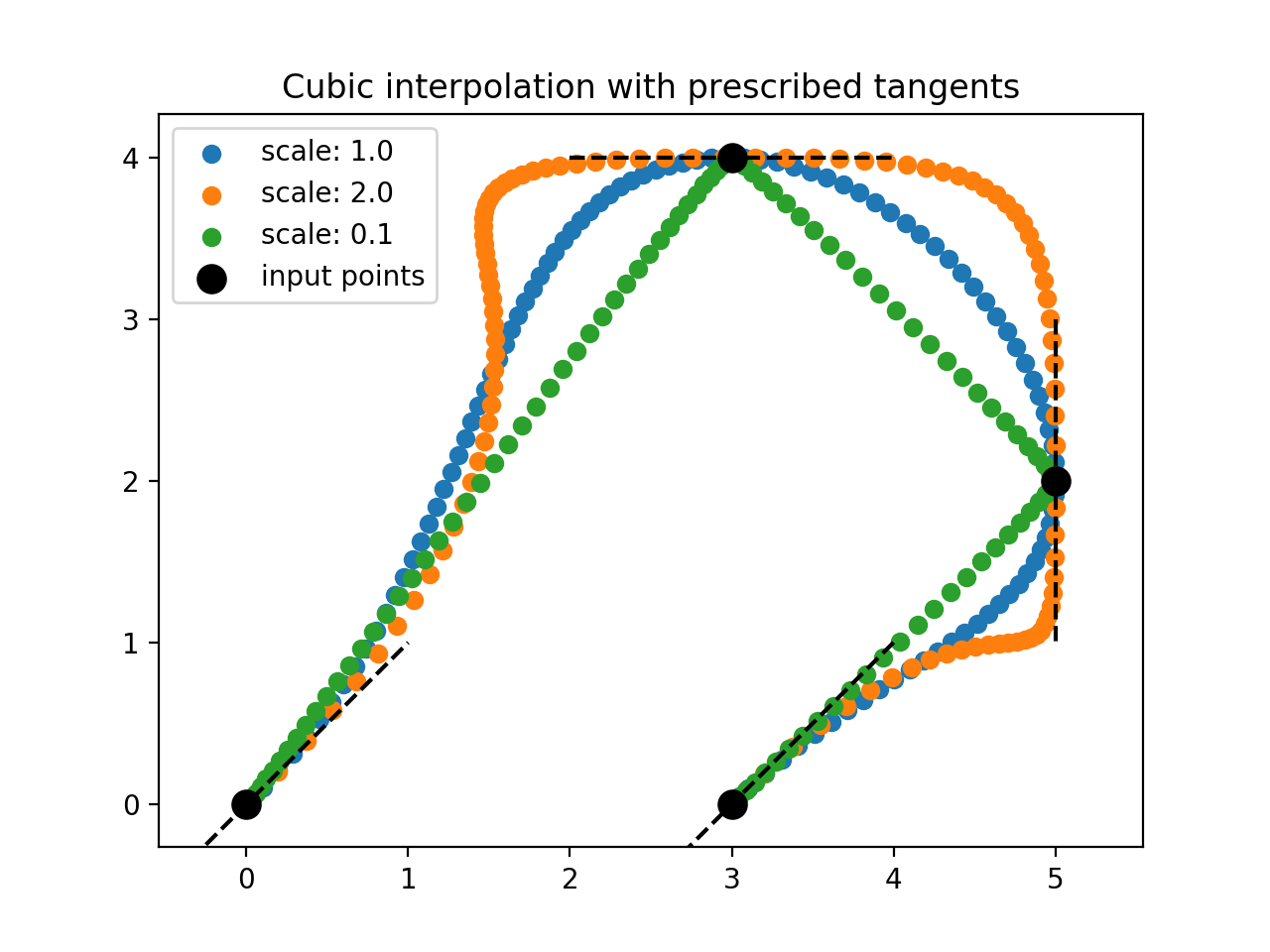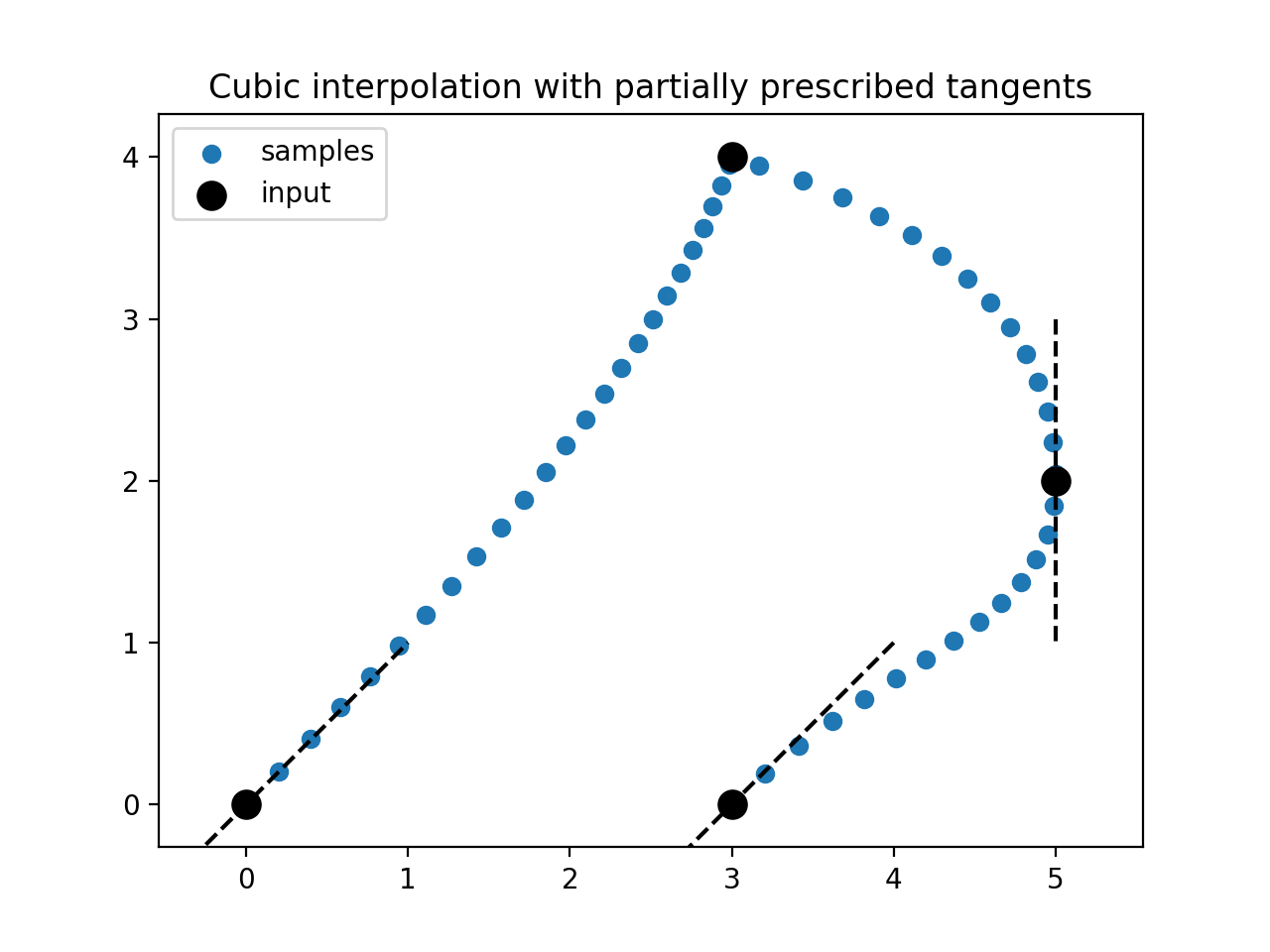Extending ev-br's answer, here some sample code that exemplifies the usage of BPoly.from_derivatives to interpolate between points in n dimensions with prescribed derivatives.
import numpy as np
from scipy import interpolate
def sampleCubicSplinesWithDerivative(points, tangents, resolution):
'''
Compute and sample the cubic splines for a set of input points with
optional information about the tangent (direction AND magnitude). The
splines are parametrized along the traverse line (piecewise linear), with
the resolution being the step size of the parametrization parameter.
The resulting samples have NOT an equidistant spacing.
Arguments: points: a list of n-dimensional points
tangents: a list of tangents
resolution: parametrization step size
Returns: samples
Notes: Lists points and tangents must have equal length. In case a tangent
is not specified for a point, just pass None. For example:
points = [[0,0], [1,1], [2,0]]
tangents = [[1,1], None, [1,-1]]
'''
resolution = float(resolution)
points = np.asarray(points)
nPoints, dim = points.shape
# Parametrization parameter s.
dp = np.diff(points, axis=0) # difference between points
dp = np.linalg.norm(dp, axis=1) # distance between points
d = np.cumsum(dp) # cumsum along the segments
d = np.hstack([[0],d]) # add distance from first point
l = d[-1] # length of point sequence
nSamples = int(l/resolution) # number of samples
s,r = np.linspace(0,l,nSamples,retstep=True) # sample parameter and step
# Bring points and (optional) tangent information into correct format.
assert(len(points) == len(tangents))
data = np.empty([nPoints, dim], dtype=object)
for i,p in enumerate(points):
t = tangents[i]
# Either tangent is None or has the same
# number of dimensions as the point p.
assert(t is None or len(t)==dim)
fuse = list(zip(p,t) if t is not None else zip(p,))
data[i,:] = fuse
# Compute splines per dimension separately.
samples = np.zeros([nSamples, dim])
for i in range(dim):
poly = interpolate.BPoly.from_derivatives(d, data[:,i])
samples[:,i] = poly(s)
return samples
To demonstrate the use of this function, we specify the points and tangents. The example further demonstrates the effect if the "magnitude" of the tangents is changed.
# Input.
points = []
tangents = []
resolution = 0.2
points.append([0.,0.]); tangents.append([1,1])
points.append([3.,4.]); tangents.append([1,0])
points.append([5.,2.]); tangents.append([0,-1])
points.append([3.,0.]); tangents.append([-1,-1])
points = np.asarray(points)
tangents = np.asarray(tangents)
# Interpolate with different tangent lengths, but equal direction.
scale = 1.
tangents1 = np.dot(tangents, scale*np.eye(2))
samples1 = sampleCubicSplinesWithDerivative(points, tangents1, resolution)
scale = 2.
tangents2 = np.dot(tangents, scale*np.eye(2))
samples2 = sampleCubicSplinesWithDerivative(points, tangents2, resolution)
scale = 0.1
tangents3 = np.dot(tangents, scale*np.eye(2))
samples3 = sampleCubicSplinesWithDerivative(points, tangents3, resolution)
# Plot.
import matplotlib.pyplot as plt
plt.scatter(samples1[:,0], samples1[:,1], marker='o', label='samples1')
plt.scatter(samples2[:,0], samples2[:,1], marker='o', label='samples2')
plt.scatter(samples3[:,0], samples3[:,1], marker='o', label='samples3')
plt.scatter(points[:,0], points[:,1], s=100, c='k', label='input')
plt.axis('equal')
plt.title('Interpolation')
plt.legend()
plt.show()
This results in the following plot:
![Cubic splines for different tangent magnitudes]()
Three things to note:
- The following can also be applied for more than two dimensions.
- The spacing between the samples is not fixed. One simple way to achieve equidistant sampling is to interpolate linearly between the returned
samples, as it has been discussed for instance in this post.
- The specification of the tangents is optional, however
BPoly.from_derivatives does not ensure smooth transitions between the splines at this position. If for example tangents[1] in the above sample is set to None, sampleCubicSplinesWithDerivative(points, tangents, resolution), the result will look like this:
![Cubic splines with only some tangents being prescribed]()


